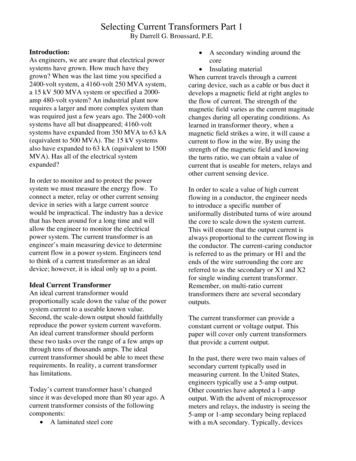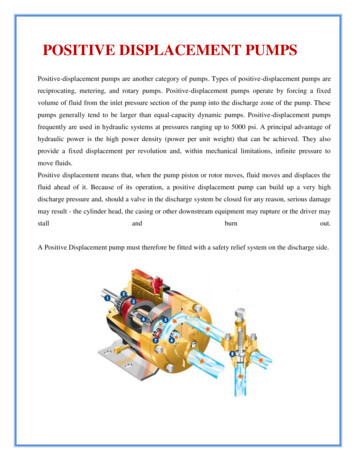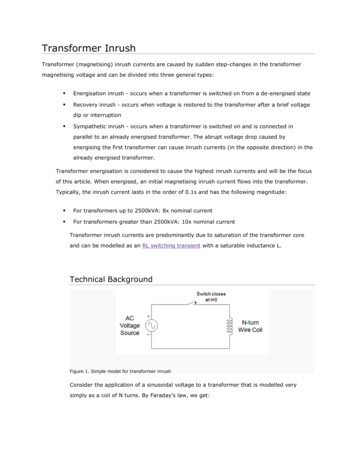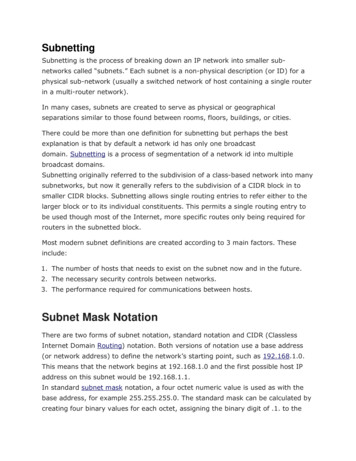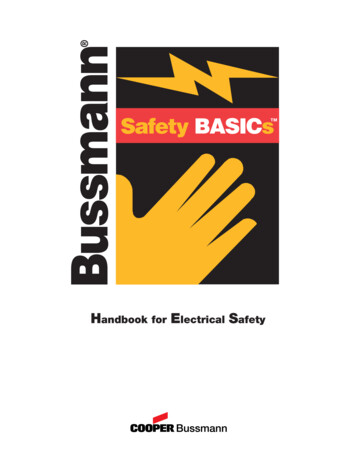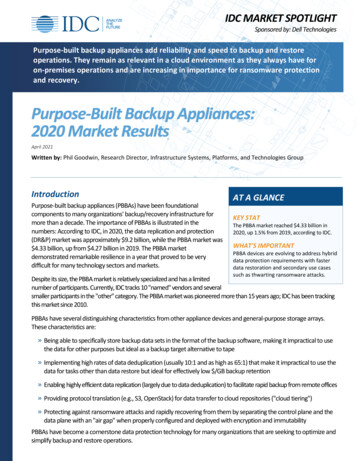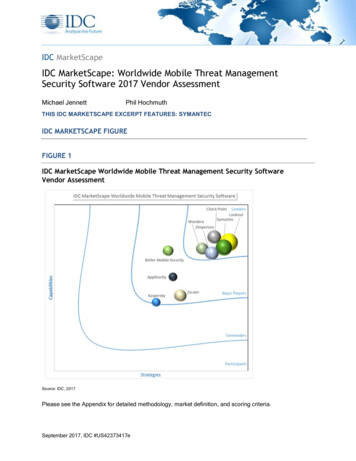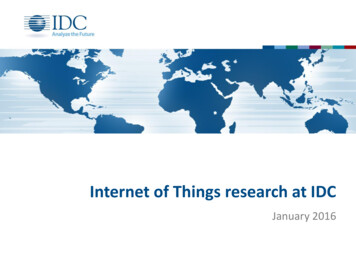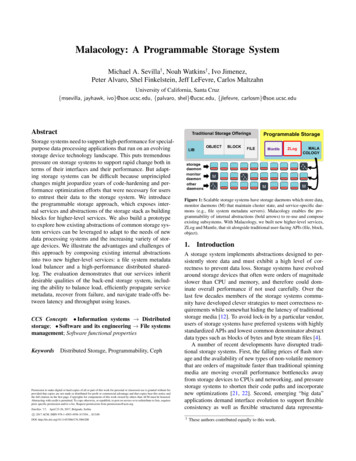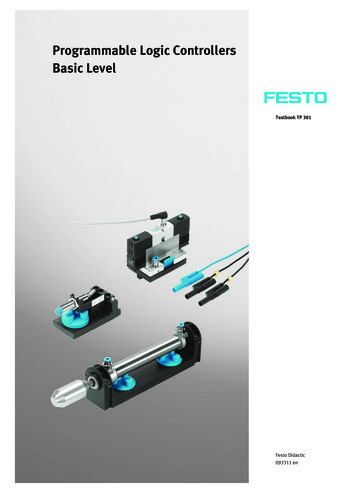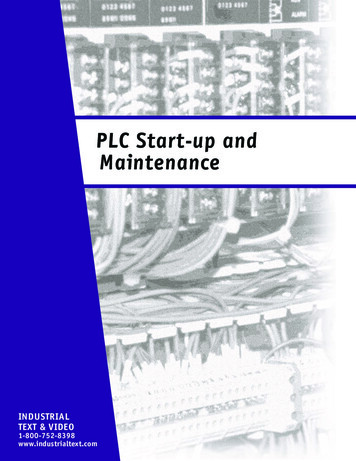
Transcription
A Special Note ToOur CustomersHere’s a valuable PLC reference that you can use right now. This particularreference is taken from our award-winning textbook—ProgrammableControllers: Theory and Implementation, 2nd Edition.In it, you’ll explore PLC installation as well as other factors that affectPLC operation, such as noise, heat , and voltage. There’s also lots ofexamples and tables to help explain the topics.Best yet, we’ve included the corresponding chapter from the companionworkbook. Here you can look over the key points as well as see howmuch you learned by answering the review questions. And, yes, theanswers are also included.This PLC reference is just a sample of what the textbook and workbookhave to offer. If you like it, we’ve included the product literature pagewith the order number.Industrial Text & Video Company1-800-752-8398www.industrialtext.com
PLC Reference BookYou covered a huge amount of detail very well. It wasvery easy to understand.—Jeff Camp, United Control Corp.The biggest book on PLCs. Written by industry experts, this book coversimportant, up-to-date, real-world programmable controller topics andapplications. This new edition is completely revised and updated to give you thelatest developments and insights from the field. At 5 pounds and 1,035 pages, itputs all the PLC information you need at your fingertips. And, since this is ageneric PLC reference, it will help you with all of the different makes and modelsof PLCs in your facility.But, this book is about more than just PLCs—it also thoroughly explains processcontrol, instrumentation, and plant networks. Whether you’re already an expert onPLCs or just starting out, our problem-solving approach is guaranteed to help you succeed.Catalog# ABT-ITV206BOOK 88 Valuable Maintenance Tips 21 Chapters of PLC Know-HowTABLE OF CONTENTS1:Introduction to Programmable Controllers2:Number Systems and Codes3:Logic Concepts4:Processors, the Power Supply, andProgramming Devices5:The Memory System and I/O Interaction6:The Discrete Input/Output System7:The Analog Input/Output System8:Special Function I/O and SerialCommunication Interfacing9:Programming Languages10:The IEC-1131 Standard and Programming Language11:System Programming and Implementation12:PLC System Documentation13:Data Measurements and Transducers14:Process Responses and Transfer Functions15:Process Controllers and Loop Tuning16:Artificial Intelligence and PLC Systems17:Fuzzy Logic18:Local Area Networks19:I/O Bus Networks20:PLC Start-Up and Maintenance21:System Selection GuidelinesIndustrial Text & VideoSELECTION, INSTALLATION & SAFETY Follow our 11 major steps in selecting a PLC for an application andavoid using the wrong controller Install sinking and sourcing inputs and outputs properly—onewrong wire and it won’t work Implement safety circuits correctly in PLC applications to protectpeople and equipment Prevent noise, heat, and voltage variations from ruining your PLCsystem Implement a step-by-step static and dynamic start-up checkout toguarantee smooth PLC system operation Design preventive safety and maintenance into your total controlsystemTROUBLESHOOTING & MAINTENANCE Learn no-nonsense troubleshooting procedures to reducedowntime Troubleshoot analog I/O and avoid undesirable count jumps Learn 6 preventive maintenance procedures to keep your PLCsystem running fault free Learn a step-by-step procedure for finding hidden ground loops Learn how to deal with leaky inputs Identify vibration problems and use them for preventiveengineering control Control excessive line voltage and avoid intermittent shutdownsPROGRAMMING Learn the number systems and codes used in PLC addressing Eliminate the confusion of ladder logic programming Master all types of timers and counters used in real-lifeapplications Avoid ladder scan evaluation problems Implement a safe circuit with hardware and software interlocking 800.752.8398 www.industrialtext.com
Programmable Controllers: Workbook/Study GuideSometimes you think you know it all, but after readingthe questions, I often times had to refer back to thetheory book.—Ernest Presto, Electrical Engineer, Polyclad Laminates, Inc.Imagine having the answers to over 800 PLC problems at your fingertips. That’swhat you get with Programmable Controllers: Workbook and Study Guide. At334 pages, it’s the perfect companion to Programmable Controllers: Theory andImplementation, 2nd Edition.This workbook provides not only valuable summaries of each of the textbook’s twenty-one chapters, but also over 800 review questions. And each ofthe review questions includes a detailed answer and explanation. Use it onthe job to brush up on the essentials and to solve any PLC problem.Whether you’re an expert or just learning about PLCs, you’ll find plenty to putyour skills to the test.You Will Learn:Catalog #ABT-ITV206WKBK 28 Proper address assignment and interfacing Basic PLC ladder program implementationSample Problem Data measurement Internal coil assignmentsA sample problem fromChapter 11 of the workbook: Proper digital and analog interfacing proceduresSystem Programming and Implementation Advanced function block programming Network protocolsQ. Analog input and output data handling Correct PLC installationCircle the locations where timertraps will be used in the PLCimplementation of this reducedvoltage start motor circuit.L1L2StartTR1StopOL1TR1Perfect textbook companion:2TR1TR13M1 800 answers to common PLCproblems at your fingertipsS1M1S1TR14S2S15 Makes a great review toolS26 Practice PLC addressing andprogramming Great on-the-job quick-reference guideL1 Separate answer sectionmakes quizzing easyA.L2StartTR1StopOL1TR12 Valuable chapter summariesTR1TR13M1TR1S1M1S14S1S25Sample pages from the workbookS26Industrial Text & Video 800.752.8398 www.industrialtext.com
PLC Start-Up andMaintenanceKey TermsControl program checkout—afinal review of a PLC’s controlprogram prior to starting up thesystem.Dynamic system checkout—theprocess of verifying the correctoperation of a control program byactually implementing it.Ground loop—a condition inwhich two or more electricalpaths exist within a ground line.Master control relay—ahardwired or softwired relayinstruction that de-energizes itsassociated I/O devices when theinstruction is de-energized.Panel enclosure—the physicalenclosure that houses a PLC’shardware and components.If I had been present at the Creation, Iwould have given some useful hints forthe better arrangement of the Universe.—Alfonso the Wise, King of CastilleSafety control relay—ahardwired or softwired relayinstruction that de-energizes itsassociated I/O devices when deenergized.System layout—the plannedapproach to placing and connecting PLC components.Wire bundling—the techniqueof grouping an I/O module’swires according to their characteristics.Industrial Text & Video Companywww.industrialtext.com1-800-752-8398
PLC Start-Up and Maintenance 1999 by Industrial Text and Video CompanyPublished by Industrial Text and Video CompanyAll rights reserved.Reproduction or translation of any part of this work beyondthat permitted by Sections 107 and 108 of the 1976 UnitedStates Copyright act are unlawful.Requests for permission, accompanying workbooks, orfurther information should be addressed to:Industrial Text and Video Company1950 Spectrum CircleTower A-First FloorMarietta, Georgia 30067(770) 240-2200(800) PLC-TEXTDue to the nature of this publication and because of the different applications ofprogrammable controllers, the readers or users and those responsible for applying theinformation herein contained must satisfy themselves to the acceptability of eachapplication and the use of equipment therein mentioned. In no event shall the publisherand others involved in this publication be liable for direct, indirect, or consequentialdamages resulting from the use of any technique or equipment herein mentioned.The illustrations, charts, and examples in this book are intended solely to illustrate themethods used in each application example. The publisher and others involved in thispublication cannot assume responsibility or liability for actual use based on theillustrative uses and applications.No patent liability is assumed with respect to use of information, circuits, illustrations,equipment, or software described in this text.Industrial Text & Video Companywww.industrialtext.com1-800-752-83982
PLC Start-Up and MaintenanceContents1 PLC SYSTEM LAYOUT .4PANEL ENCLOSURES AND SYSTEM COMPONENTS .42 POWER REQUIREMENTS AND SAFETY CIRCUITRY .13POWER REQUIREMENTS .13SAFETY CIRCUITRY .143 NOISE, HEAT, AND VOLTAGE REQUIREMENTS .174 I/O INSTALLATION, WIRING, AND PRECAUTIONS .24I/O MODULE INSTALLATION .25WIRING CONSIDERATIONS .25WIRING PROCEDURES .25SPECIAL I/O CONNECTION PRECAUTIONS .265 PLC START-UP AND CHECKING PROCEDURES .30STATIC INPUT WIRING CHECK .31STATIC OUTPUT WIRING CHECK .32CONTROL PROGRAM REVIEW .33DYNAMIC SYSTEM CHECKOUT .336 PLC SYSTEM MAINTENANCE .34PREVENTIVE MAINTENANCE .35SPARE PARTS .36REPLACEMENT OF I/O MODULES .367 TROUBLESHOOTING THE PLC SYSTEM .36TROUBLESHOOTING GROUND LOOPS .36DIAGNOSTIC INDICATORS .38TROUBLESHOOTING PLC INPUTS .38TROUBLESHOOTING PLC OUTPUTS .40TROUBLESHOOTING THE CPU .40SUMMARY OF TROUBLESHOOTING METHODS .41STUDY GUIDE .43REVIEW QUESTIONS .45ANSWERS .51Industrial Text & Video Companywww.industrialtext.com1-800-752-83983
PLC Start-Up and MaintenanceH IGHLIGHTSThe design of programmable controllers includes a number of ruggedfeatures that allow PLCs to be installed in almost any industrial environment. Although programmable controllers are tough machines, a little foresight during their installation will ensure proper system operation. In thishandbook, we will explore PLC installation, explaining the specifications forproper PLC component placement and environment. We will also explainother factors that affect PLC operation, such as noise, heat, and voltage. Inaddition, we will discuss wiring guidelines and safety precautions. Althoughproper PLC installation leads to good system operation, no programmablecontroller system is without faults. Therefore, we will investigate proactivemaintenance techniques, as well as reactive troubleshooting processes. Whenyou finish, you will understand the fundamentals of PLC start-up andoperation.1 PLC S YSTEM L AYOUTSystem layout is the conscientious approach to placing and interconnectingcomponents not only to satisfy the application, but also to ensure that thecontroller will operate trouble free in its environment. In addition to programmable controller equipment, the system layout also encompasses the othercomponents that form the total system. These components include isolationtransformers, auxiliary power supplies, safety control relays, and incomingline noise suppressors. In a carefully constructed layout, these componentsare easy to access and maintain.PLCs are designed to work on a factory floor; thus, they can withstand harshenvironments. Nevertheless, careful installation planning can increase system productivity and decrease maintenance problems. The best location fora programmable controller is near the machine or process that it will control,as long as temperature, humidity, and electrical noise are not problems.Placing the controller near the equipment and using remote I/O wherepossible will minimize wire runs and simplify start-up and maintenance.Figure 1 shows a programmable controller installation and its wiring connections.P ANEL E NCLOSURES AND S YSTEM C OMPONENTSPLCs are generally placed in a NEMA-12 panel enclosure or another typeof NEMA enclosure, depending on the application. A panel enclosure holdsthe PLC hardware, protecting it from environmental hazards. Table 1 describes the different types of NEMA enclosures. The enclosure size dependson the total space required. Mounting the controller components in anIndustrial Text & Video Companywww.industrialtext.com1-800-752-83984
Courtesy of Siemens, Alpharetta, GA, and Phoenix Contact, Harrisburg, PAPLC Start-Up and MaintenanceFigure 1. Installation of a PLC-based system using modular I/O terminal blocks.enclosure is not always required, but it is recommended for most applicationsto protect the components from atmospheric contaminants, such as conductive dust, moisture, and other co
enclosure that houses a PLC’s hardware and components. Safety control relay—a hardwired or softwired relay instruction that de-energizes its associated I/O devices when de-energized. System layout—the planned approach to placing and connect-ing PLC components. Wire bundling —the technique of grouping an I/O module’s wires according to their charac-File Size: 1MBPage Count: 57
